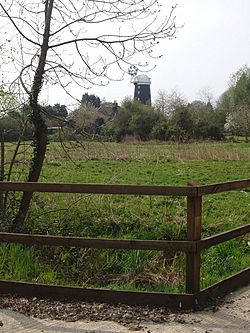Caston Windmill facts for kids
Quick facts for kids Caston Windmill |
|
|---|---|

Caston Windmill
|
|
| Origin | |
| Mill name | Caston Windmill |
| Coordinates | 52°32′47″N 0°33′54″E / 52.54639°N 0.56500°E |
| Operator(s) | Private |
| Year built | 1864 |
| Information | |
| Purpose | Corn mill |
| Type | Tower mill |
| Storeys | Six storeys |
| No. of sails | Four sails |
| Type of sails | Double Patent sails |
| Windshaft | cast iron |
| Winding | Fantail |
| Fantail blades | Six blades |
| Auxiliary power | Hornsby Oil engine |
| No. of pairs of millstones | Three pairs, a fourth pair driven by engine. |
| Size of millstones | 4 feet (1.22 m) |
Caston Tower Windmill is a historic tower mill located in Caston, Norfolk, England. It is a very important building, listed as "grade II*" and also a "scheduled monument." This means it's protected because of its special history and design. The windmill is currently being restored to its former glory.
Contents
History of Caston Windmill
Building the Mill
Caston Windmill was built in 1864. It replaced an older type of windmill called a post mill, which had been there since at least 1834. A local builder named William Wright constructed the tower. The machinery inside was installed by Robert Hambling, a skilled millwright from East Dereham.
A special stone on the mill shows "EW 1864." This refers to Edward Wyer, who owned the old post mill before the new tower mill was built.
Fires and Family Ownership
On March 24, 1895, the mill caught fire during a storm. We don't know how much damage it caused. The fire brigade from Watton helped put out the flames.
Edward Wyer continued to run the mill until he passed away in 1897. His property, including the mill, was put up for sale. However, it didn't sell right away. Edward's son, James Wyer, then took over the mill. He ran it until 1910, when he retired.
Changes and New Machines
After James retired, his uncle, Benjamin Knott, took charge of the mill. In 1915, a new main beam, called a "stock," was fitted. Then, in 1922, a new sail was added by millwright Robert Martin. The mill also got a fresh coat of paint around this time.
Benjamin Knott worked the mill until 1940, eventually with his son James. During their time, a powerful Hornsby oil engine was installed in a nearby building called the granary. This engine helped power an extra pair of millstones.
Later Years and Restoration Efforts
In 1940, James Bilham bought the mill. He mostly used the engine-driven millstones for grinding grain. He even removed two pairs of the original millstones from the windmill itself. James Bilham died in 1967, and his wife sold the mill in 1969.
A millwright named John Lawn bought the mill next. He planned to restore it so it could work again. The granary building was turned into a home. John Lawn later partnered with Philip Lennard to form Lennard and Lawn (Millwrights) Ltd. They were the only professional millwrights in Norfolk at the time.
Because they did a lot of work for the Norfolk Windmills Trust, the restoration of Caston Mill happened slowly. The top part of the mill, called the "cap," and its sails were removed in 1983. John Lawn passed away in 2000. A special plaque was placed at Old Buckenham to remember him. The cap was finally put back onto Caston Mill in 2000.
How Caston Windmill Works
Mill Structure
Caston Windmill is a tower mill with six floors. It has a two-story granary attached to it. There's also a platform, or "stage," on the second floor.
The base of the tower is about 26 feet (7.92 m) wide on the outside. Its walls are very thick, about 2 feet 6 inches (760 mm). At the top, where the cap sits, the tower is about 17 feet (5.18 m) wide. The whole tower stands tall at about 55 feet (16.76 m) to the curb level.
Cap and Sails
The top of the mill is called the "cap." It's shaped like a boat. A special device called a fantail turns the cap to face the wind. This fantail has six blades.
The mill has four large "double Patent sails." These sails have ten sections, or "bays." Eight of these bays have three movable shutters, and two bays have two shutters.
Inside the Mill
The sails are connected to a strong cast iron "windshaft." This shaft also holds a large wooden "brake wheel," which is about 10 feet 4 inches (3.15 m) wide. This wheel helps control the mill's speed.
Below the brake wheel, a "wallower" gear is attached to a wooden "upright shaft." This upright shaft goes down through the mill. The three pairs of millstones in the mill were driven from below, which is called "underdrift."
Millers of Caston Windmill
- Edward Wyer (1864–1897)
- James Wyer (1897–1910)
- Benjamin Knott (1910–?)
- Benjamin & James Knott (?–1940)
- James Bilham (1940–1967)

